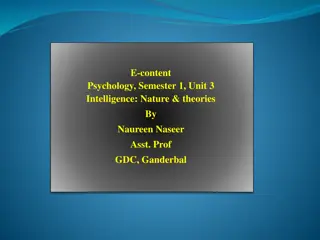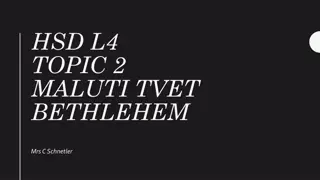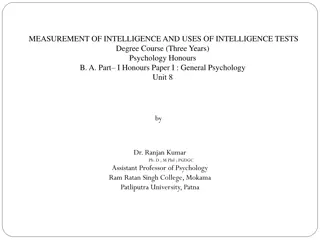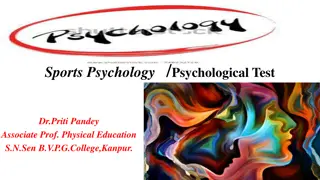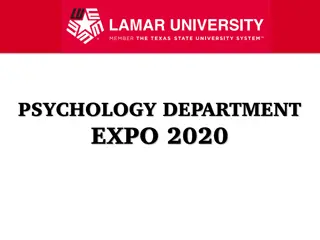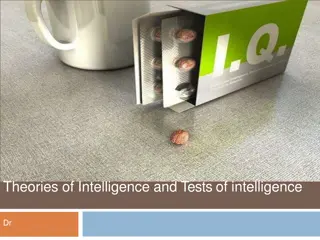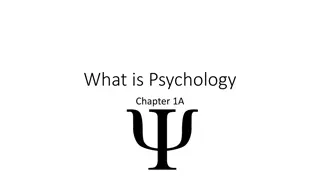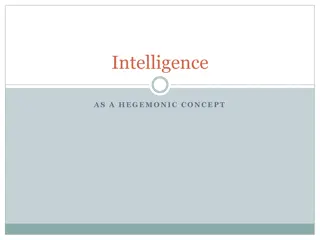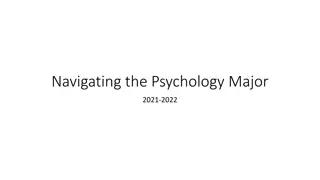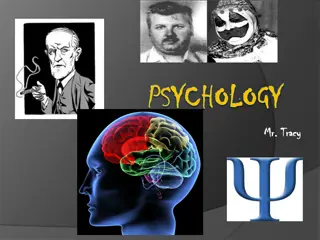Overview of Intelligence Testing in Psychology: Insights and Perspectives
Delve into the fascinating realm of intelligence testing as explored by Dr. Ranjan Kumar, covering the significance of IQ tests, the concept of intelligence, historical perspectives on intelligence measurement, and key figures like Alfred Binet and David Wechsler. Gain insights into the evolution of intelligence testing, the various dimensions of intelligence, and the cultural context of measuring intelligence.
Download Presentation

Please find below an Image/Link to download the presentation.
The content on the website is provided AS IS for your information and personal use only. It may not be sold, licensed, or shared on other websites without obtaining consent from the author. Download presentation by click this link. If you encounter any issues during the download, it is possible that the publisher has removed the file from their server.
E N D
Presentation Transcript
OVERVIEW OF INTELLIGENCE TEST Degree Course (Three Years) Psychology Honours B. A. Part II Paper III by Dr. Ranjan Kumar Ph. D ; M Phil ; PGDGC Assistant Professor of Psychology Ram Ratan Singh College, Mokama Patliputra University, Patna
TESTS OF INTELLIGENCE Do you think IQ tests are good indication of intelligence? A. Yes B. No C. Not sure
What is intelligence? A loaded question . . . Ability to understand, reason and perceive ; quickness in learning; mental alertness; ability to grasp relationships etc Buddhi, pratibha, prajna, medha, dhi,chaturya are terms used in Indian context The capacity to profit from experience and to go beyond the given
Intelligence measures(Alfred Binet,1904) The ability to judge well, to understand well and to reason well (Binet & Simon,1905) The aggregate capacity of the individual to act purposefully, to think rationally and to deal effectively with the Wechsler,1939) The ability or skill to solve problems or fashion products which are valued within one or more cultural settings(Howard Gardner,1986) is what intelligence test environment(David
Intelligence David Wechsler the global capacity person to act purposefully think rationally deal effectively with his environment
Intelligence testing in retrospect Intelligence testing in retrospect British scientist Sir Francis Galton establishes first anthropometric lab in 1884 to measure intelligence (head circumference, reaction time strength and movement, visual discrimination, breathing capacity) Father of mental testing James McKeen Cattell coined the term mental test Both reduced intelligence to sensory , perceptual and motor processes
First systematic attempt by Alfred Binet and his student T Simon in 1904 First test of intelligence consisting of 30 items came out in 1905 to identify children with special needs(Binet- Simon test) Items ranged from the ability to touch one s ear when asked, to draw designs from memory and define abstract concepts. Core of intelligence consists of more complex mental processes such as memory, imagery, comprehension and judgment
The Binet-Simon test was revised and expanded in 1908 where he introduced the concept of mental age Another version came out in 1911 William Stern introduced the concept of mental quotient in 1912(MA/CA)
First US intelligence test introduced by Lewis Terman in 1916 Revision of Binet-Simon test at Stanford University Stanford-Binet test Currently 5th revision of SB test in use Converted MQ to intelligence quotient (MA/CA x100)
Types of IQ Ratio IQ First type of IQ Stern (1938) IQ = MA/CA x 100 Same IQ has different meanings at different ages Not used as often now Deviation IQ A type of standard score Mean = 100, SD = 15/16 Compares IQ to same age peers Normal distribution WISC uses this
Standard Tools: Basic Criteria Mean =100(SD of 15) Standardization Norms Measures of Reliability Measures of Validity Proper Revision in every 10-15 years to counter Flynn effect
Classification of IQ Range CLASSIFICATION PROFOUND MR SEVERE MR MODERATE MR MILD MR BORDERLINE INTELLIGENCE AVERAGE INTELLIGENCE BRIGHT NORMAL SUPERIOR VERY SUPERIOR IQ RANGE BELOW 20 20-34 35-49 50-69 70-89 90-109 110-119 120-130 ABOVE 130
Mental Retardation ICD-10 DSM IV-TR Mild (50-69) Moderate (35-49) Severe (20-34) Profound (<20) ICD-11 Intellectual Developmental Disorder Mild (50-55 to 70) Moderate (35-40 to 50-55) Severe (20-25 to 35-40) Profound (Below 20 or 25) DSM-V-Intellectual Disability
Types of Intelligence tests Intelligence tests are broadly divided into two types based on administrative condition Group tests and individual tests Based on the nature of tests, intelligence tests are divided into Verbal Nonverbal and Performance Based on the time limit they are divided into Speed tests and Power tests
Individual test Individual test Administered to one person at a time Time consuming Allows the examiner to establish proper rapport Help in diagnosis and remediation of individual learning difficulties Standardised on relatively small samples Group test Group test Administered on a mass scale Less time-consuming Minimal role of the examiner Used for mass screening Standardised on ultra large samples
Verbal ,Non-verbal and Performance tests Verbal test demands understanding of written words Can only be administered to literates e. g. Verbal Adult Intelligence scale (VAIS) Non verbal tests Use picture or illustration as items e. g Raven s Progressive Matrices Performance tests are made up of certain concrete tasks e.g. Koh s Block Design Test, WAPIS
In speed tests there is a prescribed time limit to complete the test, Individual differences depend entirely on the speed of performance e. g. WAPIS In power tests there is no time limit to finish the test. A pure power test has a time limit long enough to permit everyone to attempt all items e. g Raven s Progressive Matrices
Performance/Non-verbal Raven s Progressive Matrices Seguin Form Board Test (3-11 yrs) Bhatia s Intelligence Battery (Above 11 yrs) Pass Along Test (Speed Test) Koh s Block Design Test(Speed Test) Porteus Maze Test
Wechslers Intelligence tests Best standardised and most widely used intelligence tests in the world Designed in 1939 by David Wechsler There are three types of Wechsler s Intelligence tests WPPSI-Wechsler s Preschool and Primary Scale of Intelligence for the age range of 4-6.5 years WISC-IV-Wechsler s Intelligence Scale for Children for the age range of 6-15 years WAIS-III-Wechsler s Adult intelligence Scale (16-24 Years) WAPIS-Wechsler s Adult Performance Intelligence Scale (15- 44 years) is the Indian adaptation of WAIS scale standardised by Prabha Ramalingaswamy in 1974
WAIS The first was Wechsler-Belluve Intelligence Scale with age range 16-64 years Replaced in 1955 by the Wechsler s Adult Intelligence Scale (WAIS) 1981 Revision is WAIS-R 1997 revision is currently in use known as WAIS-III It consists of 11 subtests(6 Verbal and 5 performance tests) It gives full scale IQ score, Performance and Verbal IQ score If the difference between VQ and PQ is more than 20 points brain dysfunction is indicated Interpretation by converting raw score into scaled score(gives IQ)
WISC First published in 1949 Revised in 1974 known as WISC-R WISC-IV currently in use Administration time varies from 1-3 hours Must be trained in order to administer complicated rules
WAPIS Performance part of WAIS adopted for Indian population by Prabharamalingaswamy in 1974 Performance scale consists of Picture completion(26 cards) Picture arrangement(9 items) Block design (10 items) Digit symbol(90 items) Object assembly(4 items)
Bhatias Battery of Performance Intelligence Test Chander Mohan Bhatia developed this test For illiterates most amenable Consists of 5 subtests Block Design(10 cards) Pass along test(8 patterns) Pattern drawing test(8 patterns) Immediate memory span(sounds/digits) Picture construction test (5 items)
1916 Stanford-Binet Sample Items for 12 yr olds Practical Problem Solving Vocabulary Grammar 1. 45.Sportive. 80.Exaltation. 92. Theosophy Orange. Interpretation Similarities Memory Snake, cow, sparrow 3-1-8-7-9 Book, teacher, newspaper Wool, cotton, leather 6-9-4-8-2 5-2-9-6-1
Verbal tests Binet- Kulakshetra Test(3-22 years) Revised and adapted for Indian conditions Gives pattern analysis for 7 primary abilities namely language, memory , conceptual thinking, reasoning, numerical reasoning, visuo-motor coordination and social intelligence Verbal Adult Intelligence Scale (VAIS) ,Indian adaptation of WAIS Verbal part Consists of information , arithmetic, digit span and comprehension subtests
Seguin form board test French physician Seguin devised it It is a performance test used mostly with children(3-11 years) and illiterates J Bharath Raj and SK Goel derived the norms for Indian population Consists of a wooden board in which the individual is required to insert 10 variously shaped blocks in the corresponding recesses as quickly as possible
Differential Ability Tests Developed by Elliott Used for analyzing and diagnosing children s learning difficulties To identify, select and classify children(2.5 to 17 years ) with learning disabilities
Consists of 20 subtests including 12 core subtests, 5 diagnostic subtests and 3 achievement subtests Provide useful information for understanding child s cognitive strengths and weaknesses
Peabody Picture Vocabulary Test Used when testing time is limited or/are subject s reading skills are poor It uses only pictures as test materials Used for age level 2.5 to 85 years
Tests for hearing handicapped Hiskey-Nebraska Test of learning Aptitude Consists of 12 nonverbal subtests administered with pantomimic directions to deaf children Wechsler s performance subtests can also be used
Tests for visually handicapped Haptic intelligence Scale for Adult Blind Wechsler s verbal subtests can be used for blind and partially sighted Perkin-Binet test of intelligence
Developmental schedules Used with severely retarded children who are not receptive to verbal, nonverbal and performance tests Also used with small children and infants Testing with infants are difficult because of short attention span and greater susceptibility to fatigue
Brazelton neonatal behavioral assessment scale Age range is 3 days to 4 weeks Scored on 26 behavioral items and 20 elicited responses including measures of neurological, behavioral and social functioning
Bayley Scales of Infant Development Age range-1 to 30 months Consists of 3 parts Mental scale Motor scale Behavioral rating scale
McCarty Scales of children abilities Age range-2.5 to 8.5 years Consists of 6 measures of intellectual and motor development Verbal Perceptual performance Quantitative General cognitive Memory and Motor
Koffmans Intelligence tests Koffman s Assessment battery for children(K- ABC) designed by A S Koffman and N L Koffman Age range -2.5 to 12.5 years It measures simultaneous and sequential mental processing
McCarthy Screening Test Author: McCarthy, 1972, 1978 Part of McCarthy Scales of Children s Abilities, Age range: 4-6 Administration Time: 20 minutes, Norm: 516 children Raw Scores determined at 10th, 20th or 30thpercentiles, hen classified as risk r non risk children, Test-Retest reliability: 0.32 to 0.99 Median 0.57 Areas: Right-Left Orientation Verbal Memory Draw-A-Design Numerical memory Conceptual Group Conceptual Grouping Leg Co-ordination 2 yrs 1. 2. 3. 4. 5. 6. 7. 38
The Developmental Screening Test (Author: Bharat Raj, 1977, 1983) Measuring mental development of children between birth to 15 years of age, Items: 88, Represents behavioural characteristics of each stage Areas: 1. Motor Development 2. Speech 3. Language 4. Personal-social Provides Developmental Age and IQ This has an IQ calculator for easy computation of IQ Validated with Seguin Form Board (r = 0.8), Columbia Mental Maturity Scale (r = 0.75), Inter-scorer reliability r = 0.928 Useful screening children with mental retardation, neurological defects, behavioural abnormalities 39
Gesell Developmental Schedule (Arnold Gesell, 1925, 1947, 1971) Age range: 4 weeks to 6 years, Direct observation & Information of Mother Developmental Age (DQ) and Developmental Quotient (DQ). Identities: behavioural abnormalities, Examiner reliability (r=0.95), Stanford Achievement Test (r= 0.64) Areas: 1. Motor development 2. Adaptive behaviour 3. Language development 4. Personal-social behaviour Supplement to medical examination in identification of MR, neurological defects and organically caused behavioural abnormalities in early life 40
Group Intelligence tests Multilevel Group intelligence Tests Used to compare intellectual growth of children over several years 1. Otis-Lennon School Ability Test(OLSAT) 2. Cognitive Ability Test 3. Wonderic Personnel Test
Culture free and culture fair tests Culture free tests are tests yielding scores that are completely independent of all cultural influences Culture fair tests are tests which are fair and appropriate for respondents of all cultures and subcultures e. g Cattell Culture Fair series, Learning Potential Assessment Device, Raven s Progressive Matrices
Ravens Progressive Matrices It is a nonverbal test of observation and clear thinking It consists of 3 matrices(Subtests) 1. Standard progressive matrices(6-80 years) 2. Coloured progressive matrices (5-11 years) 3. Adult progressive matrices for average adults
RPM assesses the two components of g identified by Spearman as educative ability and reproductive ability Educative ability refers to making meaning out of confusion, developing new insights and decision making Reproductive ability involves mastering, recalling and reproducing material which forms a cultural store of explicit, verbalised knowledge
Intelligence derived from Rorschach Above average Intelligence more than 7 W(whole) responses with good form level, M ( Movement) responses more than 5 Pure color responses 3 to 4 Percent good form responses 79% & above Low animal responses
Intelligence testing in India First systematic attempt to standardize a test of intelligence (Binet s test) was made by Dr Rice in 1930 in Urdu &Punjabi First doctorate on test construction was awarded to K G Desai in 1954 for the development of group test of intelligence in Gujarati National Library of Educational and Psychological Tests(NLEPT) at National Council Of Educational Research and training(NCERT) has documented Indian tests
Some tests developed in India Verbal tests Verbal tests 1. Group test of intelligence by Prayag Mehta 2. Group test of mental ability by S Jalota 3. Indian adaptation of Binet- Simon Scale by S K Kulshreshta 4. Test of general mental ability by M C Joshi 5. Bihar test of intelligence by S M Mohsin Performance tests Performance tests 1. Adaptation of WAPIS by R Ramalingaswamy 2. Draw a- Man test by Pramila Pathak 3. Performance test of intelligence by C M Bhatia
Biological measures of intelligence Reaction time : refers to the time gap (in seconds) between presentations of a stimulus and the beginning of a response by the individual. Intelligent person takes less time to process information Inspection time : is the minimum amount of time a particular stimulus must be exposed to an individual to make a judgment about it that meets some pre-established criteria of accuracy Shorter the IT, faster the cognitive operations
Applications of intelligence testing Utilized in various settings like schools, hospitals Foremost reason is to measure cognitive capacity Need to obtain clinically relevant information about cognitive strength and weaknesses Assess the functional integrity of the brain Assist in determining appropriate vocational or educational placement
reliable measure of individual differences important for identifying need, allocating resources reliable predictor of school achievement identify discrepancies between expected and actual performance allow for accountability, measurement of change and evaluation of program effectiveness



